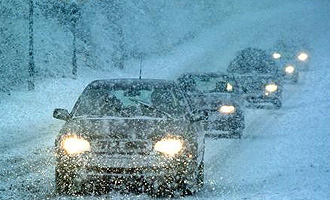| Driving in Bad Weather | << Back to Education |
Driving in Snow & Ice
Driving in severe winter weather poses many challenges. Cars can get stuck in snowy conditions even on familiar roads, forcing the driver and passengers to spend the night on the roadside.
Here is some advice on how to prepare your car for winter driving if you have to make a journey and what to do should you be caught out in bad weather.

Before You Leave
| Ensure your tyres are inflated correctly and that you have a minimum of 3mm of tread on your tyres to cope with wet and slippery conditions. | |
| In winter, the battery will run down quicker than in warmer weather. Make sure you do a regular long journey to top it up or trickle-charge the battery. | |
| Modern engines are more robust than older ones. All the same, depress the clutch when starting as this will reduce drag on the engine when starting, and preserve the battery. | |
| Keep this topped up and use a proper additive at the right concentration to prevent it freezing. | |
| Keep your tank topped up - that way if you are caught out, you'll have enough fuel to make it home or run the engine to keep warm. However, it's essential to keep snow from blocking the exhaust as noxious fumes can leak into the vehicle. | |
| Clear all snow and ice from the windscreen before driving. Do not use water to de-ice windscreens. Hot water can crack the glass, and the water will only freeze again on the screen or on the ground where you are standing. | |
| Your car may be warm on the inside but if you have to step outside, you could be in trouble if you have not got any warm clothing with you. |
Driving in Snow & Ice
| When driving in snow, get your speed right - not too fast so that you risk losing control, but not so slow that you risk losing momentum when you need it - and brake, steer and accelerate as smoothly as possible. | |
| Start gently from stationary, avoiding high revs. If you get yourself into a skid the main thing to remember is to take your foot off the pedals and steer. | |
| Only use the brake if you cannot steer out of trouble. | |
| Double or even triple your normal stopping distance from the vehicle in front. Drive so that you do not rely on your brakes to be able to stop - on an icy surface they simply may not do that for you! | |
| If your vehicle has ABS in very slippery conditions it will not give you the same control it would in others. Do not rely on it. | |
| Plan your journey around busier roads as they are more likely to have been gritted. Avoid using shortcuts on minor roads - they are less likely to be cleared or treated with salt. | |
| On motorways stay in the clearest lane where possible, away from slush and ice. Keep within the clear tyre tracks if you can. | |
| Stay in a higher gear for better control, and if it is slippery, in a manual car move off in a higher gear, rather than just using first | |
| On a downhill slope get your speed low before you start the descent, and do not let it build up - it is much easier to keep it low than to try to slow down once things get slippery | |
| In falling snow use dipped headlights or foglights to make yourself visible to others (especially pedestrians) - but as conditions improve make sure your foglights are only on if necessary as they can dazzle other drivers | |
| If you are following another vehicle at night, using their lights to see ahead can cause you to drive dangerously close - keep well back from other traffic. |
If You Get Stuck
| If you are trapped in your car, you can stay warm by running the engine. However, it is vital that the exhaust pipe is not blocked by snow. If the engine fumes cannot escape, you could be overwhelmed by carbon monoxide gas, which is highly toxic. | |
| If there is any risk the fumes can come into the car, do not run the engine. Even if it is safe, do not run the engine for more than 10 or 15 minutes in each hour. | |
| Stay in or close to your car. In heavy snow it is easy to get disorientated and lost or separated from your vehicle. If necessary you can always hang a piece of brightly coloured cloth on your car to let others know you are there. |
© ![]() has compiled this information to be used for educational purposes only
has compiled this information to be used for educational purposes only
